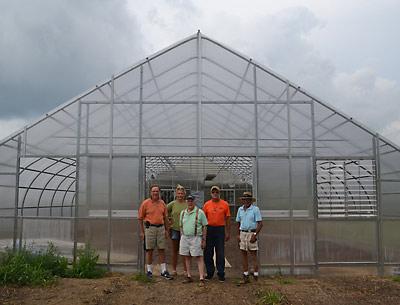From Carrots to Cauliflower

Four men on a mission delivered 34,000 pounds of fresh local produce last year to food pantries in Southampton, Sag Harbor, Springs, East Hampton, and Amagansett, the harvest of the three-acre East Hampton Food Pantry Farm on Long Lane.
The farm, now in its fourth year of operation, has recently built a 34 by 100-foot hoop house, which will extend the growing season into the fall and winter, increasing the range and volume of food it can produce for those in need.
With help from commercial growers such as Balsam Farms in Amagansett and Dale and Betty on the Bridgehampton-Sag Harbor Turnpike, a total of 17 tons of food was delivered last year to thousands of people — everything from carrots to cauliflower, broccoli to beets, sweet potatoes to watermelon.
“We also grow and deliver flowers to the pantries,” said John Malafronte of East Hampton, a former Wall Street executive. “It’s a nice pick-me-up.”
“The need is so great,” especially after Labor Day, when many who rely on seasonal business can no longer make a livable income, said Mr. Malafronte, who founded the farm with Peter Garnham of Amagansett, its director, before being joined by Bruce Warr of Montauk and Ira Bezoza of East Hampton.
The four men work diligently and regularly alongside Darcy Hutzenlaub, their full-time field manager, to increase the quantities of food they can donate. Last year a fruit orchard was added. They were quite pleased with the quality of the peaches harvested; Mr. Bezoza said they were the sweetest he’s ever eaten.
Ms. Hutzenlaub’s goal is to provide food that not only tastes good but has the highest nutritional value. (On the Brix test, which measures nutritional value, the peaches registered 15 out of 18.) “People can be malnourished no matter how much they eat,” she said.
The farm’s planting approach, including companion planting, doesn’t always create a perfect-looking carrot, she said, and those that do look good are not always healthy. Organic growing methods encourage beneficial insects, Ms. Hutzenlaub explained. Pollinators such as honeybees, for example, “love buckwheat,” she said, pointing at a spread called Buckwheat Field.
“We pay Darcy the best we can,” Mr. Malafronte said of the farm’s only paid employee, and help with her insurance and schooling.
Ms. Hutzenlaub has experimented with sustainable farming methods including last year’s “moon cycle-driven” biodynamic method, which, said Mr. Malafronte, resulted in the farm’s losing not one crop. “Today is a root day,” he said, pointing to a calendar in the Stella Natura catalog. “From noon on, it is best to plant or harvest a root crop.”
On Monday morning, children from Project Most poked their fingers in the soil. Eliza Kellman, a second-year summer intern from California, was teaching them to plant seed. “We’re starting to get groups here,” Mr. Malafronte said.
The farm is dependent on volunteers. Thirty-five people doing community service hours have worked there too, and many later returned to volunteer.
With no financial help from any municipality, “We look for volunteers, and we look for money,” said Mr. Bezoza, a lawyer. Having become a nonprofit organization in 2010, the farm had 100 donors step up to the plate last year.
The money has allowed the farmers to buy seeds, supplies, and equipment such as a compost spreader, as well as to pay their rent to the town-owned EECO farm. “We knock on doors and also hold some cookouts” to raise funds, said Mr. Malafronte.
Though they would love to have a truck, the men use their own vehicles to transport supplies and deliver the produce to the pantries. The installation and purchase of the hoop house ran about $55,000, raised by donations.
“It’s magic here,” said Ms. Hutzenlaub. “It feels good to be part of this.”
